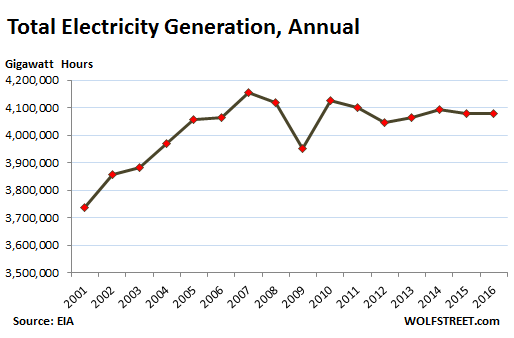The day before Jeffrey Immelt became CEO of General Electric, September 6, 2001, its stock closed at $40.50. Friday its stock closed at $28.51, and that was after an almost 11 percent jump as the market reacted to GE’s announcement that it would shed most of General Electric Capital Corporation (GECC), buy back $35 billion more of GE stock than is currently authorized, and pay out $35 billion in dividends by 2018. Analysts and investors had long pressured GE to dump GECC, and “returning money to shareholders” is all the rage on Wall Street. The market’s immediate conclusion was that Immelt had finally done something right.
GECC borrows short-term to fund long-term leases and loans. It is a business model made for modern monetary policy, which suppresses short-term interest rates and elevates asset prices, and through the years GECC, the seventh largest US financial institution, has contributed a good chunk of GE’s revenues and profits. Only the occasional financial crisis, when short-term funding dries up and asset prices decline, throws a spanner in the works. Popular lore has it that GECC and GE almost went down the tubes in the last one, necessitating a rescue from Washington. However, David Stockman argues persuasively in The Great Deformation that then AAA-rated GE, market value $600 billion, could have easily covered the $25 billion funding shortfall by selling assets or issuing equity or debt.
Immelt is the crony capitalist’s crony capitalist, a former director of the New York Federal Reserve bank and a former head of President Obama’s Council on Jobs and Competitiveness. There has been a price, however, for what GE received from the government during the financial crisis; it has classified GECC as a Systematically Important Financial Institution (SIFI). This subjects it to onerous regulatory and capital requirements. One of the rationales for GE’s move is to make SIFI go away, giving GE more flexibility with its capital.
The marginal return on investment equilibrates with the prevailing interest rate. When rates are close to zero, so too is the marginal return on investment. Confronted with this situation, investors are forced to become speculators, a stated goal of the world’s central banks. Corporate executives see the returns shrink from capital spending, hiring more people, or funding research and development, so, like the retirees who see the returns shrinking on their fixed income portfolios, they turn to the equity market and speculation. Companies have an option most retirees don’t. In addition to cash flow they can borrow at microscopic rates to fund their forays into the stock market.
Most of what passes for management consulting and investment banking wisdom is really fashion advice. In keeping with zero rates, the fashion right now is to lever up companies with cheap loans and bonds, sell “nonstrategic assets,” return money to shareholders through buybacks and dividends, promote a rising share price, and, not coincidentally, raise the value of executive stock options. Late to the show, GE is catching up to the trend, but it may be sashaying down the catwalk in oh-so-last-year’s garb. When Immelt retires in a few years he’d like that share price higher than the $40.50 it was when he started, but there’s less to this latest move than meets the eye.
While the sale of most of GECC assets will generate cash, it will also result in expected charges of $16 billion, which means GECC will be selling those assets at a loss, and there is an additional $7 billion in costs. The $23 billion total compares to combined 2013 and 2014 profits of $28 billion, so it is not small change. Sales of real estate and loans to Blackstone and Wells Fargo have been announced, and there will be bidders for other assets, but they know that GE wants to sell sooner rather than later, which never helps the bid price. The assets may be “nonstrategic,” but GECC still accounts for 25 percent of GE’s revenue and a third of its profits. While GE is getting rid of GECC’s profitable assets, it will still be on the hook for $210 billion of GECC’s liabilities.
One of the stranger features of the package is that GE will be paying $6 billion in taxes (included in the $16 billion of charges), because it will be repatriating $36 billion in profits from overseas. They are paying almost 17 percent to access their own money. Companies keep foreign profits out of the grasp of the US government, which imposes one of the highest corporate tax rates in the world, by keeping those profits abroad. The $36 billion lying fallow confirms the worldwide nature of the zero return phenomenon. Surely if anyone could find productive uses for that kind of money, GE could, but it is instead paying a $6 billion to access $30 billion for all those “shareholder friendly” actions it is taking.
Here’s a better idea. Take $535 million and give $1 million to each US representative and senator, to “facilitate” corporate tax reform. Promise Michelle Obama a place on GE’s board of directors after her husband leaves office. Assuming this gets Washington moving on long-stalled reform, each one percent reduction in the tax rate on repatriated earnings would be worth $360 million to GE. A ten percent reduction would save it $3.6 billion, a 572 percent return on the initial investment of $535 million (it would probably take far less than $1 million per legislator, but we’re using conservative assumptions), and it would only cost GE $2.935 billion total, instead or $6 billion, to bring its money home. That’s not as optimal as finding something productive to do with the money in foreign lands, but it’s still quite a saving. Immelt is just the man to execute the crony capitalistic mechanics of the plan.
GE is taking a 17 percent haircut on its $36 billion because it will need every dime of what’s left, and then some, to pay for all that shareholder friendliness. It will have to borrow money, as Moody’s noted when it cut GE’s credit rating after the announcement. Underneath all this plan’s moving parts, this is another instance of Wall Street’s favorite game of loading a company with debt and distributing the cash to the shareholders. GE is chopping off a profitable—albeit leveraged, risky, and regulated—part of its business, not so much to refocus its efforts on what used to be the trademark industrial division (its profitability lags its peers), but rather to borrow and then return more money to its shareholders than it could under its present structure.
In sleight-of-hand that could only have been dreamed up by GE’s management consultants or investment bankers, the share count will shrink just enough to offset the plan’s projected 25 cents per share charges and costs with a 25 cent gain in earnings per share due to fewer shares. All in all, it smacks of IBM, another former industrial stalwart who cannot find anything better to do with its money than give it to shareholders, augmenting cash generated from operations with borrowed funds. Anyone who wants to invest long-term in GE’s leveraged buyout of itself might want to glance at IBM’s stock chart. The stock had a good run from the financial crisis through 2012, from a closing low of $84 per share in October of 2008 to a closing high of $213 a share on the first day of trading in 2013. However, for the past three years net income has been insufficient to fund capital expenditures, buybacks, and dividends and it has borrowed to cover the shortfall. As its credit profile has deteriorated, its stock has fallen, despite rising markets in 2013 and 2014, and trades at $163 today.
Numerous Wall Street analysts have praised the GE plan, arguing that Immelt is probably selling GECC’s assets at the top of their markets, although Immelt has demonstrated no market-timing acumen to date. He made a big commitment to GECC just before the financial crises and increased energy’s share of the industrial division just before oil prices cratered. GE’s sales will generate substantial investment banking fees, so the favorable reviews are no surprise. However, it’s hard to believe anyone at Blackstone or Well’s Fargo will stay awake night worrying about being on the wrong side of these trades.
Those with a more skeptical take on GE and Immelt may be scratching their heads. This looks like some sort of ring-a-bell-at-the-top moment, but the top of what? How about leveraged financial engineering, not just at the corporate level, not just at the level of the US economy, but for the entire global economy? Like GE and IBM, the world has not produced enough to cover operating expenses and replacement costs (thus the “infrastructure crises”), borrowing to cover the shortfalls. Years from now, scholars may look on GE’s transactions as the end of an era, just as Time Warner’s acquisition of AOL in 2000 marked the peak of the dot-com craze and Blackstone’s IPO in 2007 came at a pinnacle of subprime mortgage finance, slice-and-dice securitization, and hugely leveraged speculation. Whether or not GE’s machinations come to be so recognized, its stock is not suitable for long-term, value-seeking investors. You’ll get your 3 percent plus dividend yield, but don’t count on much price appreciation. Wait until Immelt retires.
FROM A TIME WHEN PRODUCTION, NOT FINANCIAL ENGINEERING, POWERED THE ECONOMY

AMAZON
KINDLE
NOOK


